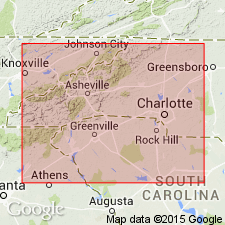
- Usage in publication:
-
- Sauratown Formation*
- Modifications:
-
- Named
- Dominant lithology:
-
- Quartzite
- Schist
- AAPG geologic province:
-
- Piedmont-Blue Ridge province
Summary:
The Sauratown Formation, here named, crops out for 24 km in Stokes and Surry Counties, NC, and includes quartzite, metagraywacke, and schist on Sauratown Mountain and Pilot Mountain, and "psammitic gneiss and schist" of Simons (1982) on Hanging Rock Mountain. At Pilot Mountain the rocks are overturned and the basal part of the quartzite unit consists of medium-grained, well-foliated conglomeratic meta-arkose which grades stratigraphically upward, but structurally downward, into massively bedded quartzite with thin interlayers of muscovite schist. Thickness at Pilot Mountain is 60 to 67 m. Nonconformably overlies Middle Proterozoic Grassy Creek gneiss basement in the core of the Sauratown Mountains anticlinorium. Overlies, possibly nonconformably, rocks of the Late Proterozoic Crossnore Complex if these are part of a Grenville basement complex rather than intrusive. The Danbury fault (Simons, 1982) juxtaposes rocks of the Sauratown against structurally higher rocks of the Hogan Creek Formation of Hatcher and others (1988). Age is inferred to be Late Proterozoic and Early Cambrian based on a possible correlation with fossiliferous rocks of the Chilhowee Group.
Source: GNU records (USGS DDS-6; Reston GNULEX).
For more information, please contact Nancy Stamm, Geologic Names Committee Secretary.
Asterisk (*) indicates published by U.S. Geological Survey authors.
"No current usage" (†) implies that a name has been abandoned or has fallen into disuse. Former usage and, if known, replacement name given in parentheses ( ).
Slash (/) indicates name conflicts with nomenclatural guidelines (CSN, 1933; ACSN, 1961, 1970; NACSN, 1983, 2005, 2021). May be explained within brackets ([ ]).

